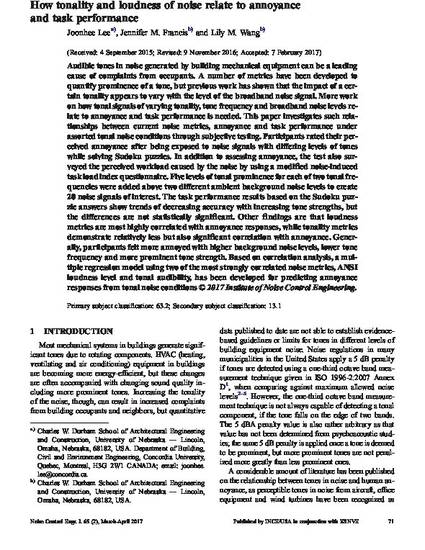
Lee, J. and L. M. Wang. (2017) “How tonality and loudness of noise relate to annoyance and task performance” Noise Control Eng. J. 65(2), 71-82.
Audible tones in noise generated by building mechanical equipment can be a leading cause of complaints from occupants. A number of metrics have been developed to quantify prominence of a tone, but previous work has shown that the impact of a certain tonality appears to vary with the level of the broadband noise signal. More work on how tonal signals of varying tonality, tone frequency and broadband noise levels relate to annoyance and task performance is needed. This paper investigates such relationships between current noise metrics, annoyance and task performance under assorted tonal noise conditions through subjective testing. Participants rated their perceived annoyance after being exposed to noise signals with differing levels of tones while solving Sudoku puzzles. In addition to assessing annoyance, the test also surveyed the perceived workload caused by the noise by using a modified noise-induced task load index questionnaire. Five levels of tonal prominence for each of two tonal frequencies were added above two different ambient background noise levels to create 20 noise signals of interest. The task performance results based on the Sudoku puzzle answers show trends of decreasing accuracy with increasing tone strengths, but the differences are not statistically significant. Other findings are that loudness metrics are most highly correlated with annoyance responses, while tonality metrics demonstrate relatively less but also significant correlation with annoyance. Generally, participants felt more annoyed with higher background noise levels, lower tone frequency and more prominent tone strength. Based on correlation analysis, a multiple regression model using two of the most strongly correlated noise metrics, ANSI loudness level and tonal audibility, has been developed for predicting annoyance responses from tonal noise conditions.
Available at: http://works.bepress.com/lilymwang/69/

Copyright (c) 2017 Joonhee Lee , Jennifer M. Francis , Lily M. Wang. Published by INCE/USA in conjunction with KSNVE